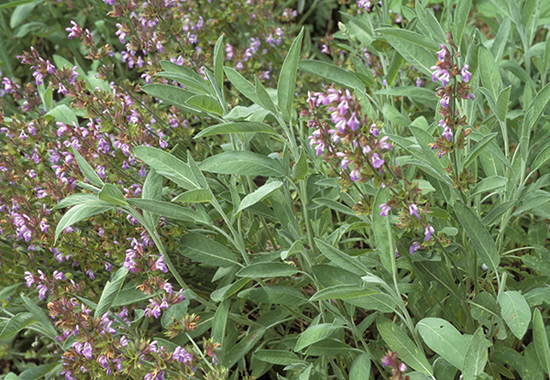
Did you know that the sage in your garden and spice cupboard can be used to treat gum disease, sore throat, dandruff, and many kinds of skin irritations? How would you like to prevent gastrointestinal distress and heart disease while improving your memory and keeping your locks from turning gray? Yeah, sage can do all that. And it’s handy in the kitchen too!
Sage (Salvia officinalis), also known as common garden sage and garden meadow, is a perennial shrub and member of the mint family native to the Mediterranean. Although we have adopted the herb’s common name from a blend of the French and English versions of sauge and sawge, respectively, its genus same is derived from the Latin salvere, which translates into “to heal,” or “to be saved.” Etymology aside, sage was once considered a heal-all for everything from snakebite and internal bleeding to warding off dementia and evil entities.
The ancient Romans believed that sage could correct infertility and prevent miscarriage, as Agrippa noted with, "Women with child, if they be likely to come before their time, do eat thereof to their great good." We know that sage was an important ingredient in the infamous Four Thieves Vinegar formula since Culpepper wrote that, “the juyce of Sage drunk with Vinegar hath been of good use in the time of Plague at all times.” Sage was so well known as a universal remedy for centuries that perhaps this is why Hildegard of Bingen, the revolutionary female composer of several treatises on the healing properties of plants, posed this question in the 12th century: “Why should a man die whilst sage grows in his garden, if not because nothing can stand against death?”
John Gerard further acknowledged the restorative powers of sage in the 16th century when he wrote, “Sage is singular good for the head and brain; it quickeneth the senses and memory; strengtheneth the sinews; restoreth health to those that hath the palsy; and takes away shaky trembling of the members.” While this statement may sound like a sweeping glorification of a long-time herbal panacea, modern science gives us reason to think otherwise. In fact, there is ample evidence to suggest that certain components of sage, such as 1,8-cineole, exhibit significant enzymatic action in the brain that impacts memory, concentration, and mood. Specifically, these compounds block the activity of cholinesterase, an enzyme that breaks down an important neurotransmitter called acetylcholine, the decline of which is strongly associated with the onset of Alzheimer’s disease and other age-related cognitive disorders. We would be remiss to forget that Pliny the Elder wrote about sage’s ability to improve memory as long ago as 77 AD.
Other constituents found in sage contribute to the herb’s medicinal properties, most notably rosmarinic acid, borneol, camphor, a-pinene, and thujone. In fact, studies have shown that sage extracts demonstrate antibacterial, antifungal, antiviral, antispasmodic, hypoglycemic, and estrogenic qualities. In terms of the latter, sage has been traditionally used to promote menstruation and is used today in Europe to ease certain symptoms of menopause. However, since a few studies indicate that sage may stimulate uterine contractions, it would be wise for pregnant women to avoid high concentrations of this herb beyond normal culinary use. The same applies to nursing women since very high doses of sage may cause lactation to cease.
One particularly interesting effect sage has is to help prevent night sweats and excessive perspiration by as much as 50 percent, which is likely why it was a popular Medieval remedy to check fever. Currently, the Commission E of Germany officially approves of the use of sage infusions to treat excessive sweating, and in the U.S. the herb is a common ingredient in many natural deodorants. Due to its antibacterial and antiviral properties, sage is also a popular ingredient in natural mouthwashes to deter gingivitis. When used as a gargle, sage tea is exceptionally effective for treating bleeding gums, canker sores, and sore throats. The Commission E has also approved the use of sage infusions to treat indigestion and other gastrointestinal disorders.
While we can’t comment on the reputed use of sage to treat snakebite or internal bleeding, there is something to be said about the herb’s anticoagulant properties. Japanese researchers have recently discovered that sage inhibits the formation of abnormal blood clots, indicating that the herb may prove useful in the prevention of cardiovascular disease. This is likely due to the presence of ursolic acid, a triterpene saponin that appears to improve capillary strength. This acid also exhibits potent antioxidant and anti-inflammatory properties. In fact, studies have shown that this substance suppresses histamine release from mast cells in response to allergy, helps to relieve enlarged prostate, and inhibits the enzyme protease responsible for the replication of a modern day plague—the HIV virus.
Sage is also great for treating various skin disorders. For instance, the next time you find yourself the victim of a bee sting or insect bite, just snag a sage leaf from the garden and chew it slightly to make an on-the-spot poultice. A simple wash made from strong sage tea will relieve poison ivy, psoriasis, eczema, and dandruff. And, if you’re seeing more gray in your hair these days, you can treat your tresses to a strong infusion made from equal parts of sage and black tea leaves to naturally darken it.
Of course, sage has also gained notoriety has a favorite culinary herb. The distinctive peppery flavor lends itself well to soups, stews, sauces, bread stuffing, and to add savory zest to poultry, pork, sausage, cheese, and even some beverages. It is widely used in Mediterranean, Middle Eastern, Italian, and French cuisine, and an American Thanksgiving would hardly be recognizable without it. In fact, we’re featuring a few special recipes this month that we’re sure your friends and family will be very thankful for indeed!
Check out some of our sage recipes:
